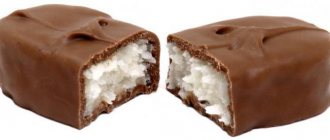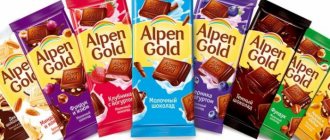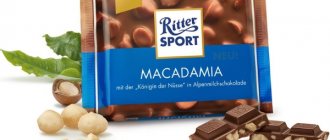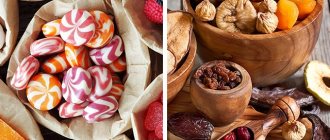History of appearance
Before milk chocolates appeared, cocoa beans came a long way. It began in America, where ancient Indian tribes used this raw material to prepare a hot, bitter drink with spices. For the Mayans, cocoa beans were sacred.
The product migrated to Europe much later - after the discovery of America - and also in liquid form. They put sugar, vanilla, pepper, corn flour, and salt in it. Mostly wealthy people drank this drink. In the UK, milk was first added to it, and this can be considered the beginning of the history of liquid milk chocolate.
Reference
The Dutch began making solid chocolate at the beginning of the 19th century, adding cocoa butter, which has the ability to harden. But then these were dark or bitter species. But the first officially released milk bar was produced in 1875, when powdered milk and more sugar were introduced into the recipe.
Interesting Facts
Known interesting events:
- Buryonka was depicted on the packaging almost immediately after the appearance of chocolate. It officially became a symbol only in 1972. At first it was white on a purple background, a little later spots appeared.
- For advertising, they take a white cow and paint spots on it with purple spray paint, which is easy to wash off. This was first done back in the nineties of the last century.
- The most famous advertising cow is the Russian Swallow. She starred in commercials in the 90s, then she was taken to Switzerland. About 6 thousand francs were spent on its maintenance per year.
- Now this brand supplies more than 100 thousand tons of chocolate to the world market every year.
- In the Vladimir region, in the city of Pokrov, a monument to chocolate was erected: a chocolate fairy holding a bar of Milka chocolate.
- In Ukraine, since 2011, the brand has officially supplied New Year's toys - Christmas tree decorations.
Compound
Let's consider what ingredients are included in the product, in what quantities, as well as what beneficial compounds are present in milk chocolates.
What are regular and porous made from?
According to GOST 31721-2012 (interstate standard), milk chocolate is chocolate made from cocoa, milk and sugar. According to the rules, it must contain at least:
- 25% total cocoa solids;
- 25% total fat;
- 12% milk powder or its processed products;
- 2.5% milk fat;
- 2.5% non-fat cocoa solids.
The main ingredients are cocoa butter, powdered or grated cocoa, milk and sugar. In most cases, vanilla is used as a flavoring agent, and soy lecithin is used as an emulsifier (for homogeneity and thickness of the mass). Various products are used as fillings - nuts, pralines, raisins and other dried fruits, candied fruits, berries, etc.
Aerated milk chocolate is made from the same components, so its composition differs from a monolithic bar only in the presence of air bubbles.
Nutritional value (BJU)
Data on BJU per 100 g are as follows:
- proteins – 9.8 g;
- fat – 35 g;
- carbohydrates – 50.5 g;
- dietary fiber – 1.3 g;
- water – 1 g.
These are average figures for chocolate without filling and fillers. They may vary slightly for different brands and types. For example, Alenka milk chocolate contains 8 g of protein, 33 g of fat and 54 g of carbohydrates, while for Nesquik these figures are different - 7.7 g, 34.1 g and 52.9 g, respectively.
What vitamins and microelements does it contain?
The richest in beneficial composition are the bitter varieties. However, dairy also contains mineral elements and vitamins, but in smaller quantities:
- Among the vitamins it contains, the leading ones are B2, PP and B5; it also contains B1, E, B9, B6 and A.
- Of the macroelements, most are phosphorus and calcium, slightly less potassium, magnesium, sodium and sulfur.
- Microelements are represented by manganese, copper, iron, iodine and fluorine.
Other useful substances
Chocolate owes its content of most biologically active and healthy substances to cocoa beans. The product contains theobromine, phenylethylamine, tryptophan, several antioxidants, flavonoids, and polyphenols. Some of them have a stimulating effect on the nervous system, others, on the contrary, soothe, others tone and rejuvenate, have anti-inflammatory and mild analgesic activity. But the listed effects are more pronounced in bitter and dark varieties than in dairy varieties.
Calorie content per 100 grams, how many calories are in a bar, in a slice
100 g contains 550 kcal. Calorie content deviates slightly in one direction or another for different manufacturers and depending on the specific composition. If chocolate contains nuts or dried fruits, the energy value increases. If we start from 550 kcal, take the weight of the bar as 100 g, and the number of slices in it is 6, then the calorie content of one slice will be 92 kcal. You can calculate the calories in a slice and cube of any brand of chocolate yourself in this way.
Chocolate "Alenka": brand history
Chocolate “Alenka” is a long-awaited and favorite treat for many children in the USSR. Let's remember the history of its origin, understand the nutritional and harmful properties of the product.
In the 60s of the last century, the USSR government, when adopting a food program, introduced a clause on the creation of a new milk chocolate, which must be tasty and different from others. A competition was announced, as a result of which the confectionery factory, now known in many countries - “Red October” was declared the winner. It was she who had to fulfill the government order.
In addition to the individual recipe, there were requirements to create a bright and recognizable wrapper. Artists tried different images. There were ideas to make Alenka with carnations, to portray her as the Snow Maiden, to draw her with pigtails.
They also proposed to present on the wrapper the famous painting “Alyonushka”, painted by Vasnetsov. But “at the top” this idea was criticized. After all, the country has a happy childhood, and the girl on the canvas has bare feet.
The first "Alenka" did not have a permanent design. Chocolate was produced with different images and shades of wrapper. The first chocolate bar from the Babaevskaya factory depicted a girl in a blue scarf on the wrapper. And Rot-Frontovsky Chocolate released two images for sale: with a watering can and a girl depicted with a dog and a bunny.
Initially, the chocolate was released in the traditional commemorative design in honor of Labor Day and March 8, but it was also released without an image at all.
But in 1964 it was decided to use it in permanent design.
The factory announced a competition for a photograph of a girl to be depicted on a chocolate wrapper. Gerinas's wife remembered the photograph that was published in Health magazine in 1962. Her daughter was 8 months old at that time. As a result, it was decided to take this image as the basis.
For the wrapper, the girl was painted on and her facial features were slightly changed. The brown color of the eyes turned blue, the face became longer, the cheeks were rosy, the lips were swollen, and the gaze was drawn in the other direction. Since 1966, this image has helped to become a famous brand not only in the USSR, but also far beyond its borders.
In 2000, Elena Gerasimova sued Red October because the factory had used her image for many years. The investigations continued over many years, and as a result of many examinations, it was recognized that the image reflected a new independent image.
Article on the topic: How to cook squid for salad so that it is soft
There are legends that chocolate received its name in honor of Tereshkova’s daughter Valentina, while others claim that Gagarin’s daughter received this honor. But in fact, the choice fell on a name that was common, popular and evoked fairy-tale heroines.
Alenka milk chocolate is a delicacy made from cocoa fruits. The product has a homogeneous structure with a delicate aroma and sweet taste.
The sweet is prepared from grated cocoa beans. Additionally, add cocoa butter, powdered sugar, milk powder or cream. Also, Alenka chocolate contains emulsifiers and flavorings.
Due to its nutritional and taste qualities, sweetness is widely used in cooking.
If we consider the composition of 100 g of product, then the carbohydrate content is 53.23 g, protein – 8.9 g, and fat 33.71 g. Calorie content is 544.07 kcal.
In the USSR, “Alenka” enjoyed enormous success. The famous tile was a must-have attribute not only for children's gifts, but also for adult gifts.
Types of chocolate "Alenka"
Since 1966, chocolate began to be produced in our usual form by different chocolate factories, but in the end, “Red October” finally secured the brand for itself.
Big chocolate: assortment
The bars are produced in weights of 100, 200 and 60 g. Traditionally, the first bars were produced only in milk flavor without additional additives.
In 2000, it was decided to diversify the assortment and chocolates appeared on sale:
- with almonds;
- with hazelnuts;
- with raisins and hazelnuts;
- with a high milk content.
Since then, the packaging method has changed. The first chocolates were inserted into a wrapper, now they are wrapped.
Nowadays you can buy not only chocolate bars, but also candies. The wrapper is decorated in the usual way for us.
Small chocolate
Small bars, which can be called portioned, are produced weighing 20 and 15 g. This is ordinary milk chocolate without various additives.
Light weight tiles are still released inserted into the package.
The benefits and harms of Alenka chocolate
Eating sweets is good for adults and children, but in moderation.
- The substances that make up cocoa have a beneficial effect on the nervous system. With moderate consumption, you will feel a surge of positive emotions and your mood will lift.
- Chocolate helps to cope more easily with depression, irritability, stress, and apathy.
- Stimulates the cardiovascular system. Improves blood microcirculation.
- If you suffer from increased fatigue and lethargy, chocolate can quickly raise your vitality and saturate your body with strength and energy.
- With small consumption, testosterone production is stimulated in men, which is beneficial for their health.
- The musculoskeletal system, as well as teeth and bones, are strengthened.
Harmful properties:
- May cause allergic reactions. If during or after consumption redness appears on the body or you feel itching, you should subsequently completely exclude the product from your diet.
- Due to its high calorie content, consumption by overweight people and diabetics is prohibited.
- It has a harmful effect on teeth and provokes the development of caries.
The product should not be used by people with diseases:
- pancreatitis;
- cholecystitis;
- stomach ulcer;
- intestinal ulcer;
- with a tendency to flatulence and constipation;
- with bloating.
It is recommended to exclude the delicacy completely during pregnancy and breastfeeding and for children under three years of age.
Why does it burn
After watching various videos on the Internet, many are shocked by the sight of burning chocolate.
Let's figure out why chocolate burns. The tile, most of it, consists of oil. And as everyone knows, oil burns. Cocoa butter, which is part of the chocolate bar, is also flammable. A burning match or a flame from a stove has a high temperature, at which the chocolate does not have time to melt and begins to burn.
Source: https://zdorov-today.ru/shokolad-alenka-istoriya-brenda/
Benefits and harms of the product
No matter what odes are sung to a chocolate bar about how this product lifts your spirits and saves you from depression, you need to remember about rationality. The benefits are undeniable, but only when consumed in small quantities and, to be completely truthful, they are significantly less than those of bitter varieties.
Why is it useful?
Here are the valuable properties of the product:
- improves mood, helps to cope with stressful situations;
- is a source of calcium and phosphorus, which is beneficial for bone tissue;
- thanks to a large amount of vitamin B2, it increases skin elasticity, supports hematopoietic function and the functioning of the reproductive organs and endocrine glands;
- relieves PMS in women;
- increases libido in both sexes;
- invigorates and tones due to the presence of theobromine;
- strengthens the walls of blood vessels.
Since the product contains cocoa and sugar, it helps to increase brain activity, and as a result, better performance.
Harm and contraindications
Chocolate should not be consumed under the following conditions:
- diabetes;
- severe diseases of the liver and pancreas;
- gastritis, stomach ulcers, other gastrointestinal problems;
- increased acidity;
- nervous excitability;
- diseases of the central nervous system;
- elevated cholesterol levels, the presence of atherosclerotic plaques;
- overweight, obesity;
- hypertension;
- allergy to the product;
- gout;
- children under 3 years of age;
- the presence of stones in the kidneys, bladder, ureters or bile ducts.
Reference
The daily intake of the product is no more than 30 g, but it is important to control the consumption of other types of chocolate and sweets. Children over 3 years old should not be given more than 20 g of product per day and no more than 2-3 times a week.
The potential harm lies in the exacerbation of these contraindications. Also, with excessive consumption, there is a high risk of developing diabetes and weight gain. You should eat chocolate with caution during pregnancy. During breastfeeding, the product is introduced into a woman’s diet when the child is 4 months old.
Which chocolate is healthier - dark chocolate or milk chocolate?
The answer to this question is clear – black (bitter) is healthier. This is due to the fact that it contains much more cocoa and less sugar, and there are no milk fats. Therefore, all the properties that cocoa has are most pronounced in bitter varieties.
Reference
Dark chocolate is not so dangerous for your figure. And compared to dairy, it has a low glycemic index (25 versus 70), so it does not lead to a sharp jump in glucose levels after consumption.
Poll: Which chocolate do you like best?
GorkyMilk
Sugar-free chocolate for diabetics
For diabetes, dark chocolate with a cocoa content of at least 75% or special diabetic chocolate is recommended, which contains vegetable fats, sugar substitutes, and the calorie content does not exceed 400 kcal per 100 g.
If you do not have diabetes, but want to lose weight or strictly monitor the calorie content of your foods and limit your intake of sugar, then pay attention to dairy varieties with sweeteners. For example, chocolate with stevia is popular, which is produced by many, “Cavalier”, “Valor”, “Villars”, “Eco-botany”.
Chocolate eggs "Milka"
Chocolate eggs are filled with filling - this is their difference from standard kinders with their only shell.
There are 3 types of chocolate milk eggs:
- With delicate cream – white filling. They are equipped with a special lid that is easy to open to get to the cream. The flavor of the filling is caramel-vanilla.
- With chocolate cream and alpine milk. For those who recognize nothing but chocolate, both outside and inside.
- With Oreo cookies. The chocolate-covered eggs contain a white, fluffy whipped soufflé filling and Oreo cookie pieces.
Each set contains 4 chocolate eggs. The set includes two spoons so that your child can eat comfortably with a friend. The set will be a nice Easter gift for a child.
Which one is the best and most delicious?
In different countries, the following brands are leaders in terms of taste and quality:
- in Russia – “Victory of Taste”, “Loyalty to Quality”, “Golden Mark”;
- in Switzerland - “Lindt”, “Toblerone”, “Chocolat Frey”, “Villars”, “Milka”;
- in Belarus - Kommunarka, Spartak;
- in Germany - “Ritter Sport”, “Stollwerck”, “Hussel”.
Reference
Belgian chocolate is rightfully considered the standard, since in Belgium the attitude towards the production of this product is very serious, strict and at the same time creative. Therefore, both taste and quality are always at their best with Belgian brands - “Godiva”, “Neuhaus”, “Pierre Marcolini”, “Guvlian”, “Jean Galler”, etc.
The main competitors of Milka chocolate
Main competitors in chocolate production:
- Nestle is the largest manufacturer of food and beverages worldwide. About 2 thousand brands belong to this company. Nestlé has been creating food products for about 150 years.
- Ferrero is a chocolate and confectionery company. On the market for over 70 years. 38 brands belong to this manufacturer.
- Mars – collects the largest profit on the sale of chocolate. The company owns many famous brands of chocolate bars.
Milka's assortment of chocolate, cookies and other sweets will not leave even the most picky sweet tooth indifferent. These sweets are sold in stores all over the world.
Selection of real milk chocolate, storage conditions
If you are interested in purchasing a quality product, then the following nuances must be taken into account:
- The composition should not contain cocoa shells, vegetable oils (palm, cottonseed, sunflower, etc.), confectionery or hydrogenated fat.
- It is better if the list of ingredients does not indicate powder, but grated cocoa, and vanilla instead of vanillin.
- The tile should be smooth, with a slight glossy sheen, without graying or whitish deposits.
- Don't buy into a cheap product. The cost of a bar of high-quality milk chocolate cannot be lower than 80-100 rubles, and the price of an elite chocolate bar exceeds this amount by 4-7 times.
The product should be stored at a temperature of +15...+21 °C, in a dark place, with a relative humidity of no more than 75%. The refrigerator is not a suitable place for storage. The tightness of the packaging is also important - no foreign odors should enter the product.
Chocolate Alenka: composition, calorie content, types
Chocolate “Alenka” is a long-awaited and favorite treat for many children in the USSR. Let's remember the history of its origin, understand the nutritional and harmful properties of the product.
Chocolate "Alenka": brand history
In the 60s of the last century, the USSR government, when adopting a food program, introduced a clause on the creation of a new milk chocolate, which must be tasty and different from others. A competition was announced, as a result of which the confectionery factory, now known in many countries - “Red October” was declared the winner. It was she who had to fulfill the government order.
In addition to the individual recipe, there were requirements to create a bright and recognizable wrapper. Artists tried different images. There were ideas to make Alenka with carnations, to portray her as the Snow Maiden, to draw her with pigtails.
They also proposed to present on the wrapper the famous painting “Alyonushka”, painted by Vasnetsov. But “at the top” this idea was criticized. After all, the country has a happy childhood, and the girl on the canvas has bare feet.
The first "Alenka" did not have a permanent design. Chocolate was produced with different images and shades of wrapper. The first chocolate bar from the Babaevskaya factory depicted a girl in a blue scarf on the wrapper. And Rot-Frontovsky Chocolate released two images for sale: with a watering can and a girl depicted with a dog and a bunny.
Initially, the chocolate was released in the traditional commemorative design in honor of Labor Day and March 8, but it was also released without an image at all.
But in 1964 it was decided to apply it in permanent form.
Who is pictured on the packaging of Alenka chocolate?
The factory announced a competition for a photograph of a girl to be depicted on a chocolate wrapper.
Gerinas's wife remembered the photograph that was published in Health magazine in 1962. Her daughter was 8 months old at that time. As a result, it was decided to take this image as the basis. Ten mistakes you make when trying to eat healthy
For the wrapper, the girl was painted on and her facial features were slightly changed. The brown color of the eyes turned blue, the face became longer, the cheeks were rosy, the lips were swollen, and the gaze was drawn in the other direction. Since 1966, this image has helped to become a famous brand not only in the USSR, but also far beyond its borders.
In 2000, Elena Gerasimova sued Red October because the factory had used her image for many years. The investigations continued over many years, and as a result of many examinations, it was recognized that the image reflected a new independent image.
There are legends that chocolate received its name in honor of Tereshkova’s daughter Valentina, while others claim that Gagarin’s daughter received this honor. But in fact, the choice fell on a name that was common, popular and evoked fairy-tale heroines.
Composition, calorie content and BJU of sweets
Alenka milk chocolate is a delicacy made from cocoa fruits. The product has a homogeneous structure with a delicate aroma and sweet taste.
The sweet is prepared from grated cocoa beans. Additionally, add cocoa butter, powdered sugar, milk powder or cream. Also, Alenka chocolate contains emulsifiers and flavorings.
Due to its nutritional and taste qualities, sweetness is widely used in cooking.
If we consider the composition of 100 g of product, then the carbohydrate content is 53.23 g, protein – 8.9 g, and fat 33.71 g. Calorie content is 544.07 kcal.
In the USSR, “Alenka” enjoyed enormous success. The famous tile was a must-have attribute not only for children's gifts, but also for adult gifts.









